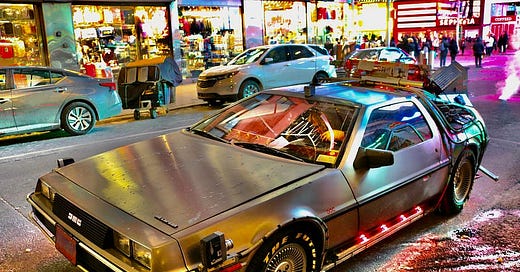Back to the…Future?
I had an interesting experience last weekend. On Friday my son came to me from school with the following question:

I had an interesting experience last weekend. On Friday my son came to me from school with the following question:
“Did you know that they are trying to make flying skateboards?”
To which I answered,
“Yes, they are trying to catch up, they should have been ready by 2015!”
He looked at me with a confused face, until I told him there was a movie called “Back to the Future 2” in which hoverboards were featured. Since Friday Night is our official “Homemade Pizza and movie night for the family”, he asked to see that movie, and we ended up watching the trilogy over the weekend.
I said it was…interesting. These 3 movies are a clear product of their time -mid-1980s to early 1990s- they follow a fun albeit formulaic (I always wanted to put these 2 words together, checked) story and they are forever part of my youth.
However.
A few things stood out, some of which look quite different to me when analyzed in today’s light.
(Spoiler alert: if you haven’t seen the movies, shame on you, you’re more than 30 years late to the game. Go watch them and then keep reading. Or proceed at your own risk.)
Weird plot devices and choices
In 8 months in the Wild West past of 1885, the most advanced machine Dr. Brown was able to build was a freezer the size of a room that produces one ice cube at a time. Fast forward to a few years later, and he has been able to build a time-traveling flying steam engine. Talk about accelerated innovation.
The movie happens in the fictional town of Hill Valley, CA. However, when Marty travels back in time to 1885, he runs into Native People riders being chased by the cavalry…in Monument Valley, on the border between Utah and Arizona. After which he walks to Hill Valley. Where have all those mountains gone, Marty?
Garbage packs in the back alleys in 2015 are full of laser discs. Laser discs were garbage way before that.
It looks like everyone has been in town for generations, with both the McFly and the Tannen families (and the Jones manure-hauling empire) having been there since at least 1885. Nobody ever leaves..?
Speaking of families: Marty’s great great grandmother on his father’s side looks exactly like his mother. How much endogamy is there in that family?
Biff Tannen works (in some kind of untrustworthy indentured servitude) for Marty’s family, after bullying his father and trying to rape his mother. This is such a good example of turning the other cheek.
Speaking of Biff, was he modeled after a certain political figure…or was it the other way around?
Such obvious product placement is everywhere. Everywhere.
No, that’s not the original actor Crispin Glover in the second movie. It was a sneaky move by the studio and was settled through a large, trailblazing lawsuit.
Language
It was a bit more colorful than what I remembered it to be. Had to distract my son from numerous s*** bombs.
Violence
Most conflicts in the movie are resolved with the villain being punched in the face. And/or a big load of manure.
Sexism
Women are for the most part damsels in distress, spectators, or trophies, who usually end up sitting down on the floor, all flustered, while their hero settles the score with the villain.
Diversity
There seems to be very little of it. The movie happens mostly in California, and yet there are no Latinos, except for the ones that play the Libyans (?!)
Appropriation
Chuck Berry learned to rock and roll from Marty. Not sure Chuck Berry was happy about that.
Stereotyping and racism
In the alternate 1985 future, Lyon Estates has become a dangerous neighborhood. There is trash in the streets, abandoned crash cars, crime scene tapes and silhouettes, and bars in every window.
Based on the provided information, can you guess the skin color of the family who lives in the house where the McFly family used to live in the original movie…? You probably guessed right.
Conclusion
As you can imagine, all of this led to several interesting conversations with my son, who is Black and has been bringing MLK biography books from the school library (some of which are WAY beyond his 7-year-old reading level, but they have been very instructive for me, when I have to read them to him at night).
The future is not dictated by a movie, and we have no right to expect hoverboards in the stores (although they are definitely coming). But helping my son understand the perspectives from the past can inform his interpretation of the present and -hopefully- his vision for the future.
Note: The point of this article is neither to ruin the movies for anybody nor to cancel the movie, its actors, writers, or directors. The intention is simply to point out how the depiction of the present (and the future) depends on the zeitgeist, the spirit of the era. And how this changes with time and requires frequent re-interpretation, and it is valuable to use these dated depictions as triggers for enriching conversations.




